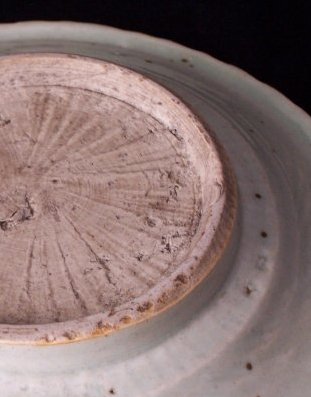Chatter Marks
Chatter marks are production traces found on round porcelain objects. They are mainly found on items of the Ming and early Qing dynasties. They can be almost invisible or rather prominent. Sometimes only the part near the foot rim or center is visible, especially if the bottom is covered with thick glaze; sometimes they may be completely invisible.
|
The example on the right shows chatter marks on a plate from the Ming dynasty, interregnum period (1436-1457). While these marks may be found more frequently on late Ming porcelain, they are also occasionally found on earlier Ming dynasty porcelain and on items of the early Kangxi reign (Qing dynasty). Porcelain items that may have chatter marks are thus mainly found in items from a period spanning about 200 years. Not all thrown items do have chatter marks, though. Sometimes items of the same type, made during the same period and with the same methods may have none.
Generally said, smaller items like bowls or cups frequently do have less visible or no chatter marks at all.
|
Prominent chatter marks
on unglazed bottom
|
Chatter marks developed when the bottom of a round item was cleaned using a shaving tool (usually made of bamboo). After the item was formed on the wheel and dried, it would be placed upside down on the wheel once more to shave the bottom clean.
The wooden potting wheels used in those times were not completely even. The fluctuation (flutter) of the spinning wheel when the shaving tool was held to the bottom would result in these ray-like lines. During the Kangxi reign these production marks disappeared almos completely, probably because of better production methods or tools.
Return from Chatter Marks to Homepage
|
|
Last update: 28. Aug. 2024

